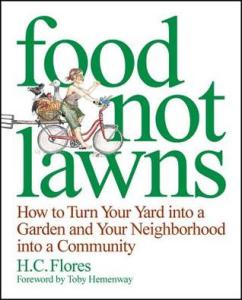 Title: Food Not Lawns: How to Turn Your Yard Into a Garden and Your Neighborhood Into a Community
Title: Food Not Lawns: How to Turn Your Yard Into a Garden and Your Neighborhood Into a Community
Author: Heather Jo Flores
Genre: Environment/Sustainability
Trigger Warnings: Moralizing about food
Back Cover:
Gardening can be a political act. Creativity, fulfillment, connection, revolution–it all begins when we get our hands in the dirt.
Food Not Lawns combines practical wisdom on ecological design and community-building with a fresh, green perspective on an age-old subject. Activist and urban gardener Heather Flores shares her nine-step permaculture design to help farmsteaders and city dwellers alike build fertile soil, promote biodiversity, and increase natural habitat in their own “paradise gardens.”
But Food Not Lawns doesn’t begin and end in the seed bed. This joyful permaculture lifestyle manual inspires readers to apply the principles of the paradise garden–simplicity, resourcefulness, creativity, mindfulness, and community–to all aspects of life. Plant “guerilla gardens” in barren intersections and medians; organize community meals; start a street theater troupe or host a local art swap; free your kitchen from refrigeration and enjoy truly fresh, nourishing foods from your own plot of land; work with children to create garden play spaces.
Flores cares passionately about the damaged state of our environment and the ills of our throwaway society. In Food Not Lawns, she shows us how to reclaim the earth one garden at a time.
Review:
Full disclaimer: I’m in a couple of Heather Jo Flores’s Facebook groups. I’ve never actually interacted with her, though, and she doesn’t know I’m reading/reviewing her book, so I like to think it’s still sort of unbiased.
This book has a lot of good information. There’s two main categories of information here: tips for gardening and turning your yard into a garden, and tips for activism within your community. This is more a reference guide than anything else – you definitely can sit down and just read it straight through (which is what I did), but the book clearly wants you to go out and put its ideas into practice.
I found the gardening part very interesting, as it explains permaculture methods (vastly different from the industrial agriculture I grew up with) and advice for turning your yard into a “food forest”-type garden. It talks about plants that complement each other when grown together, different “zones” of a garden, soil microbes, and a lot more. I’ve been interested in the concept of permaculture, and I found this a really good basic introduction to the principles.
The community activism part was also good information, although parts of it seemed more pie-in-the-sky than practical (especially in the bit about fundraising). I’m sure Heather Jo has used all of the methods she said in this book that she used, but I don’t think they’re all universally applicable. That said, a lot of the ideas did sound good, at least in theory, and I’d be willing to give them a try.
Overall, this was a solid book. Heather Jo and I have some different ideas on things (for example, I don’t think GMOs are inherently evil), but overall I appreciated how relentlessly practical this book is. It’s a book that wants you to go out and do the things it’s telling you about, and though I read it as an ebook, I fully intend to get my hands on a paperback copy so I can have it on hand to reference as I start trying to actually do some permaculture gardening.
